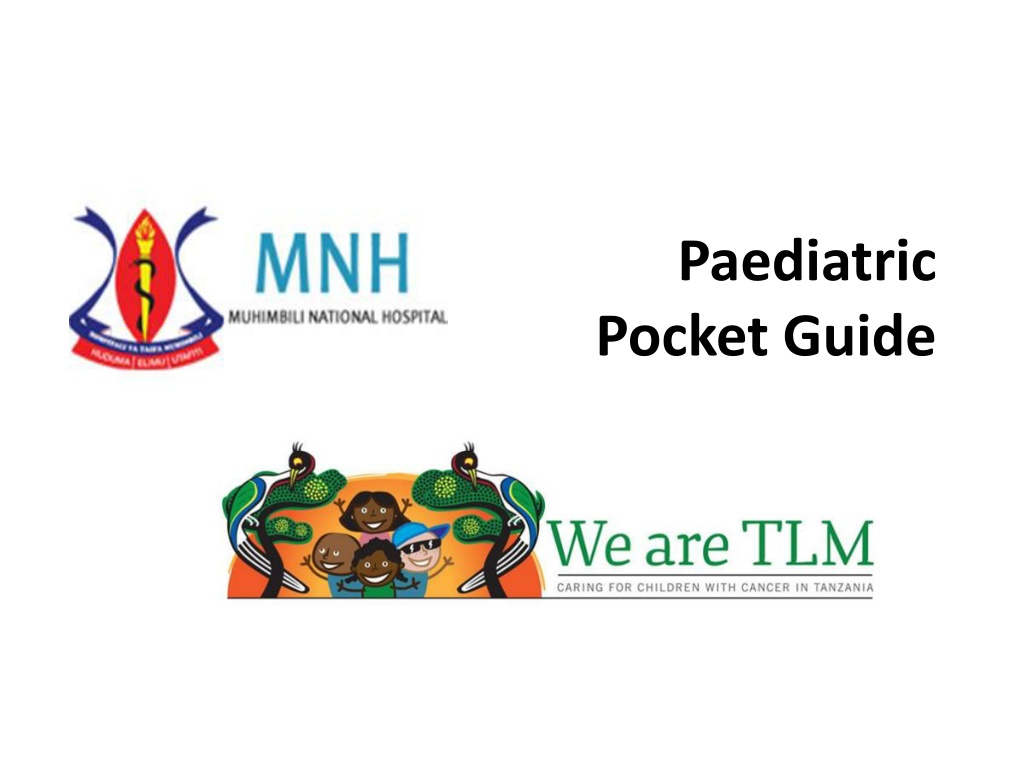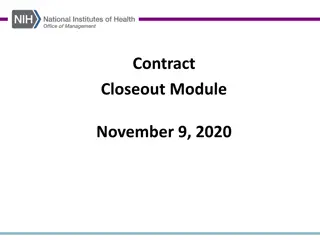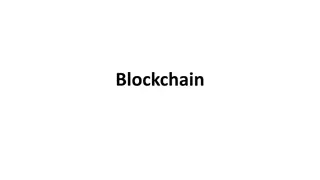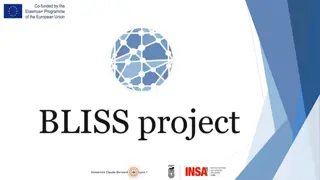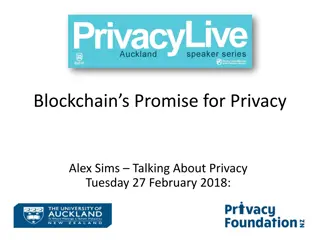Arbitrating Blockchain & Smart Contract Disputes Conference
Dive into the 22nd Annual Spring Conference by the American Bar Association Section of Dispute Resolution focusing on arbitrating blockchain, smart contract, and smart legal contract disputes. Learn from experts like Peter L. Michaelson, Esq., and Sandra A. Jeskie, Esq. Explore topics such as the importance of trust, blockchain distributed ledgers, smart contracts vs. legal contracts, and more.
Uploaded on Mar 02, 2025 | 0 Views
Download Presentation

Please find below an Image/Link to download the presentation.
The content on the website is provided AS IS for your information and personal use only. It may not be sold, licensed, or shared on other websites without obtaining consent from the author. Download presentation by click this link. If you encounter any issues during the download, it is possible that the publisher has removed the file from their server.
E N D
Presentation Transcript
Paediatric Pocket Guide
Cardiac Arrest first steps Check Call Compress Child is unresponsive or only gasping Shout for help! Push hard and fast on the chest at a rate of 120 compressions per minute 1 Check pulse every 2 minutes Call the senior on- call and ICU for anaesthetic help Continue effective CPR @ 15:2 Give breaths with Bag-valve-mask 2
Cardiac Arrest management Continue CPR 15 compressions : 2 breaths Give adrenaline IV asap 0.1ml/kg 1:10, 000 Check pulse every 2 minutes Continue to push adrenaline IV every 4 minutes
What do you need for PEWS? Correct age chart Phone or watch Thermometer Portable BP machine (charged) O saturation monitor
Select correct age PEWS chart 1 Patient assessment, record vital signs 2 Document vital signs in Orange or Purple boxes 3 Escalate appropriately 4 Take action: Trigger specific action 5
Patient assessment Patent airway? Noisy breathing? Respiratory rate Too fast or too slow? Airway Breathing Respiratory distress Working too hard? Or not enough? Oxygen saturation Low? Heart rate Too fast? Too slow? Irregular? Blood pressure Too high? Too low? Changed? Circulation Capillary refill time Skin temperature Too hot? Too cold? Disability (neurological) Conscious level AVPU Temperature Too warm? Too cold? Pain Needs more pain relief? Exposure Rash Allergy? Sepsis? Wounds Bleeding? Discomfort? Infection?
Need to know normal resting heart rates for the age of the child
Reasons heart rate may change in paediatric oncology patients Respiratory distress Pain Pyrexia Bleomycin may cause pulmonary toxicity (long term side effect) Hypovolaemia Cardiac abnormalities Pressure from tumours Fluid volume excess Anaemia Hypovolaemia Anaphylaxis (eg: asparaginase, carboplatin, etoposide) Medication Anxiety Increase:- Decrease:- Hypoxia Impending cardiac arrest Opioids, benzodiazepines
Important to know normal respiratory rates for the age of the child
How to assess Respiratory Effort How to assess Respiratory Effort Mild Moderate Severe Airway Stridor on exertion or crying Mild stridor at rest Stridor at rest Increased irritability or lethargy Looks exhausted Unable to talk or cry Unable to feed or eat Some intermittent irritability Difficulty talking/crying Difficulty feeding or eating Normal Talks in sentences Behaviour and feeding Respiratory rate in purple box Increased or markedly reduced respiratory rate as the child is tired Mildly increased Respiratory rate in orange box on PEWS Respiratory rate Marked intercostal, suprasternal and sternal recession Nasal flaring Mild intercostal and suprasternal recession Marked intercostal, suprasternal and sternal recession Accessory muscle use Mild hypoxaemia corrected by oxygen Increasing oxygen requirement Hypoxaemia may not be corrected by oxygen Oxygen No oxygen requirement Gasping, grunting Extreme pallor, cyanosis Apnoea Other Child seems well Child seems unwell Call the intern to discuss the findings Call the intern to urgently review the child and tell the on-call specialist
Reasons respiratory rate may change in paediatric oncology patients Respiratory distress Pain Pyrexia Bleomycin may cause pulmonary toxicity (long term side effect) Hypovolaemia Cardiac abnormalities Pressure from tumours Fluid volume excess Anaemia Anxiety Increase Decrease Respiratory failure Anaesthetic agents Opioids Benzodiazipines
Reasons BP rate may change in Paediatric oncology patients Fluid overload Medications (eg: ciclosporin, steroids) Pain Anxiety Renal problems Increase:- Sepsis Shock Hypovoleamia Anaphylaxis Medications (eg: etoposide especially if given too quickly. Best given over 2-4 hours) Opioids, benzodiazepines Decrease:-
ISBAR Effective Clinical Communication Observation in Orange zone Observation in purple zone Call the intern to discuss the observations Call the intern to urgently review the child and tell the on-call specialist Use ISBAR to escalate the PEWS to the doctor I Identify Your name, the doctor, the patient S Situation I am calling because B Background The relevant background is A Assessment I think the problem is I am worried about R Recommendation I need you to
Fluid calculations I.V. Fluid Calculation = drops per min I.V. Fluid Calculations (based on 20 drops/ML check giving set) Volume to be infused (mls) Drop factor 1 Litre of Fluids over... ml/hour drops/min _____________________ X ___________ 12 hours 83.3 28 Time in hours 60 minutes 10 hours 100 33 8 hours 125 42 6 hours 166.6 56 Resuscitation fluids in medical emergency Resuscitation fluids in trauma or neurological emergency 10ml/kg NaCl rapid push 20ml/kg NaCl IV rapid push Adrenaline in cardiac arrest Adrenaline in anaphylaxis 0.1ml / kg 1:10, 000 0.1ml / kg 1:10, 000
MATHS CONVERSIONS 1 Gram = 1,000 milligrams (mgs) 1 Gram = 1,000,000 micrograms (mcgs) FORMULA FOR CALCULATION OF DRUG DOSAGE: 0.01 mgs = 10 mcgs (0.01 X 1,000 = 10) To convert Milligrams to Micrograms X milligrams by 1,000 WHAT YOU WANT x VOLUME (mls) = AMOUNT TO What you have 1 BE GIVEN (ensure all units are the same) 2 grms = 2,000,000 mcgs (2 x 1,000,000 = 2,000,000) To convert Grams to Micrograms X grams by 1,000,000 Example What you want: 175mg of liquid paracetomol What you have: Liquid paracetamol 120mg/5ml divide the micrograms by 1,000 500 mcgs = 0.5 mgs ( 500 1,000 = 0.5) To convert Micrograms to Milligrams 175 X 5 = 7.29 mls 120 1
5 MOMENTS OF HAND HYGIENE BEFORE PATIENT CONTACT WHEN? Clean your hands before touching a patient when approaching him/her 1 WHY? To protect the patient against harmful germs carried on your hands WHEN? Clean your hands immediately before any aseptic task BEFORE AN ASEPTIC TASK 2 WHY? To protect the patient against harmful germs, including the patient s own germs, entering his/her body WHEN? Clean your hands immedicately after an exposure to body fluids (and after glove removal) AFTER BODY FLUID EXPOSURE RISK 3 WHY? To protect yourself and the health-care environment from harmful patient germs WHEN? Clean your hands after touching a patient and his/her immediate surroundings when leaving AFTER PATIENT CONTACT 4 WHY? To protect yourself and the health-care environment from harmful patient germs WHEN?Clean your hands after touching any object or furniture in the patient s immediate surroundings, when leaving even without touching the patient AFTER CONTACT WITH PATIENT SURROUNDINGS 5 WHY?To protect yourself and the health-care environment from harmful patient germs
Visual Infusion Phlebitis Score IV site appears healthy 0 No signs of phlebitis OBSERVE CANNULA Possible first sign of phlebitis One of the following is evident: *Slight pain at IV site *Redness near IV site 1 OBSERVE CANNULA Two of the following are evident: *Pain *Erythema * Swelling 2 Early stage of phlebitis RESITE CANNULA All of the following signs are evident: *Pain along the path of the cannula *Erythema *Induration 3 Medium stage of phlebitis RESITE CANNULA CONSIDER TREATMENT Advanced stage of phlebitis or start of thrombophlebitis All of the following signs are evident and extensive: *Pain along the path of the cannula *Erythema *Induration *Palpable venous cord 4 RESITE CANNULA CONSIDER TREATMENT All of the following signs are evident and extensive: *Pain along the path of the cannula *Erythema *Induration *Palpable venous cord *Pyrexia 5 Advanced stage of thrombophlebitis INITIATE TREATMENT RESITE CANNULA
Blood transfusion It is acceptable to allow patients have a Hb level of 8g/dl before RCC transfusion is required. Aim to increase haemoglobin to 10g/dl Formula for Calculating Amount of RCC Required : Formula for Calculating Amount of whole blood Required 3 x weight in kilo x desired increase in g of Hb = number of millilitre needed. 6 x weight in kilo x desired increase in g of Hb = number of millilitre needed. eg. A 20 kg child with a Haemoglobin of 5 gs/dl. The desired rise is to 10 gs/dl, therefore 3 x 20 x 5 = 300mls. eg. A 20 kg child with a Haemoglobin of 5g/dl. The desired rise is to 10 g/dl, therefore: 6 x 20 x 5 = 600mls.
Blood transfusion reaction Some children may develop a minor reaction to blood or platelets e.g. mild allergic or urticarial reaction Review by Doctor If a minor reaction occurs intravenous Chlorpheniramine (Piriton) and Hydrocortisone should be prescribed and given promptly. Piriton > 2 years old = 4 mg IV Hydrocortisone < 4 years old = 25 mg IV > 4 years old = 50 mg IV < 2 years old = 2 mg IV
Febrile Neutropenia Temperature 38.3 on one occasion or Temperature 38.0 and 38.2 on at least two occasions, taken at least one hour apart Defined as per the absolute neutrophil count (ANC) which is the sum of the neutrophils and band forms. An ANC < 1 x 109/L is the critical value below which all patients should be treated
Febrile Neutropenia Evaluation - examination Vital signs Skin, especially folds, areas surrounding nail beds, CVC exit sites, sites of BMA and LP Sinuses Oropharynx Perineum, particularly the perianal and labial regions
Febrile Neutropenia Investigations Investigations Complete blood count Blood smear for malarial parasites Kidney function Liver function Blood cultures Urine culture (especially younger children) Additional investigations if needed CXR if respiratory Abdominal Xray/ultrasound scan if gastrointestinal Lumbar puncture for altered mental status or meningitis (if it is safe) Stool culture and C. difficile toxin test if diarrhoea Culture and Gram stain of drainage from any site with drainage
Initiate antibiotic treatment if Patient is febrile and ANC < 1 x 109/L, or ANC 1x 109/L and ANC expected to fall below 1 x 109/L within the next 24 to 48 hours, it is advisable to initiate antibiotic treatment. Patient is febrile and the neutrophil count is unavailable in the acute stage but the patient recently received chemotherapy and therefore is at risk of neutropenia.
Febrile Netropenia Guidelines for initial (first-line) and subsequent (second-line deteriorating patients) empiric antibiotic selection. Patient Condition Antibiotics & Doses Comments PATIENTS withno significant beta-lactam reactions: Piperacillin-tazobactam (Tazocin) 90 mg/kg/dose IV 6 hourly (max single dose: 4.5g) Adjust Tazocin doses for renal impairment. Tazocin usually provides adequate coverage for G positive organisms includingviridans streptococci. However, if additional coverage against resistant G positive organisms (e.g. coagulase negative staph, MRSA) is desired, the addition of Vancomycin is recommended. Consider discontinuation of Vancomycin once culture and susceptibility results are available. DETERIORATING PATIENTS on first line treatment with no history of anaphylaxis to Beta Lactams (i.e. if history of rash only, can still use Meropenem) Meropenem 20 mg/kg/dose IV 8 hourly Meropenem: Max single dose: 1g Ciprofloxacin: dose reduce if creatinine clearance <20ml/min/1.73m2, use half normal dose. Max single dose: 400mg AND Amikacin 7mg/kg/dose OD (OR Ciprofloxacin 10 mg/kg/dose IV 12 hourly OR Gentamicin 7mg/kg once daily in 50-100ml 0.9% w/v NaCI by infusion over at least 30minutes) Maximum dose of GENTAMICIN is 400mg daily. AND Vancomycin 12mg/kg/dose 8 hourly
PATIENTS with history of definite anaphylaxis to Beta Lactams Ciprofloxacin 10 mg/kg/dose IV 12 hourly AND Metronidazole 7.5mg/kg/dose IV 8 hourly AND Amikacin dose as above AND Vancomycin dose as above CEFOSO (cefoperizone and sulbactam 1g+1g) Doses are expressed in terms of cefoperazone. 20-40 mg/kg/day, given in equally divided doses every 6- 12 hours. Adjust ciprofloxacin doses for renal impairment. Max single dose: 400mg Metronidazole max single dose: 500mg. PATIENTS deteriorating despite the above treatment where you suspect or confirm resistant gram negative bacteria. May cause pseudomembranous colitis. Renal impairment: Dose adjustments may be needed. Reconstitution: sterile water for injection/normal saline/ 5% dextrose in water, and then diluted to 20 ml using the same diluent followed by admin over 15-60 minutes. For serious infections: Up to 160 mg/kg/day, given in 2-4 equally divided doses may be used. Max dose of sulbactam: 80 mg/kg/day In an effort to avoid or minimize aminoglycoside-induced hearing loss, patients with known, significant, pre-existing hearing loss (sensorineural hearing loss 30dBHL at one or more frequencies between 250Hz-4000Hz) or renal impairment(i.e. GFR 60mL/min/1.73m2, serum creatinine 1.5 times upper limit of normal for age, or Hepatoblastoma protocol-directed chemotherapy and no significant beta lactam allergy should receive single agent Ceftazidime only (with the addition of oral Metronidazole if anaerobic infection suspected) rather than gentamicin. Similar patients with significant beta lactam allergy may receive one dose of aminoglycoside.
Management of Pain The WHO describes three steps in analgesic prescribing the Analgesic Ladder +nonopioid +co-analgesics Step 3 Strong opioid Weak opioid + nonopioid + co-analgesics Step 2 Nonopioid +/- co-analgesics____ Step 1 Principles of Ladder Ladder serves as guide. Start patient on step 1, 2 or 3 depending on severity of pain. If pain persists or increases, move up to the next step of the ladder. Where pain persists always consider use of coanalgesia where appropriate. Remember psychosocial issues which may be contributing.
Non Opioids- Step 1 Drug Single dose for child >1month 10 15mg/kg PO or Freq. Forms available Comment Paracetamol (Calpol/Panadol) Tablets 500mg Maximum: Liquid 120mg/5ml 250mg/5ml 60mg/kg/day 20mg/kg PR or 4 6hrly or 3 12mth: 60mg 120mg PO 1 5yrs: 120mg 250mg PO 6 12yrs: 250mg 500mg PO 12 Adult: 500mg 1g PO 5mg/kg PO or 4g/day whichever is lower Ibuprofen (Brufen/Nurofen) Tablets: 200mg, 400mg 600mg,800mg retard Maximum: 6 8hrly 2.4g daily or 20-30mg/kg which ever is lower. 1 2yrs: 50mg 3 7yrs: 100mg 8 12yrs: 200mg >12yrs: 200 600mg Liquid 100mg in 5ml Granules 600mg sachet Tablets 25mg, 50mg Diclofenac (Voltarol/Difene) 300microgs 1mg/kg PO/PR 8hrly Not recommended for children less than 6 months. Maximum dose: 3mg/kg/day or 150mg which ever is lower Please do not give suppositories to PAEDIATRIC HAEMATOLOGY/ONCOLOGY patients.
Weak Opioid Step 2 Drug Single dose for child > 1 month 0 12mth: 0.5mg/kg/dose >12mth:0.5 1mg/kg/dose >12yrs: 30 60mg/dose Frequency Forms available Codeine Linctus 15mg/5ml Comment Codeine Phosphate 4 6hrly Maximum dose: 240mg daily or 60mg per dose. Codeine phosphate tabs (Codant) 30mgs Tablets 30mg Dihydrocodeine (DF 118 Tablets / Paracodin Liquid) 1 4yrs: 0.5mg/kg 4 12yrs: 0.5mg 1mg/kg > 12yrs: 30mg 4 6hrly Not for children <1 year. 90% effective at 30mg dose no need to increase dose above this. Do not prescribe with other opiates. Liquid: 12mg/5ml There is a ceiling effect with weak opioids i.e. a max dose is reached beyond which further dose escalation doesn t improve analgesia. Notes: Constipation should be anticipated and laxatives prescribed. Injections of both dihydrocodeine and codeine are available but should be avoided in paediatrics.
Strong Opioid Step 3 Oral morphine is the drug of choice in the majority of children with severe pain. Children can tolerate very large doses of morphine if titrated appropriately. MORPHINE DOSE TITRATION: There is no such thing as a standard dose of morphine; no upper limit. To obtain control initially: The dose has to be adjusted for each child until their pain is controlled. Prescribe an appropriate dose, according to weight (usually give a range). Start low and work up Use an immediate release morphine preparation (oral morphine suspension) for dose titration. Give it regularly every 4 hours. At the same time prescribe the same dose for breakthrough pain to be repeated as often as necessary between regular doses. Review after 24 48 hours and adjust regular dose according to breakthrough requirements. A common dose increment is between 25 30% of the previous dose. (minimum increase 20%, maximum increase 50%). Starting dose: 1 12 months 0.1mg/kg 4 hourly 1 12 years 0.2 0.5mg/kg 4 hourly To calculate total amount of morphine given in a 24 hr period: 5mg oral morphine suspension given 4hrly for 24hrs: = 5 x 6 = 30mg 5mg breakthrough dose needed twice in 24hrs: 5 x 2 = 10mg 30mg + 10mg = 40mg = total morphine in that 24hrs (If it is available it may be possible to convert to 12hrly sustained release preparation (MST): 40mg 2 = 20mg twelve hourly dose as sustained release PLUS Now calculate breakthrough dose = 1/6th of total daily dose: 40mg 6 = 5mg PRN given as instant release morphine. Intravenous / Subcutaneous morphine if available: Conversion from oral to I.V/S.C route: Divide oral dose by 2 to obtain equianalgesic dose. Initial Morphine Loading Dose I.V: 0.05 0.1mg/kg (50 100 microg/kg) over 10 minutes. Infusion Rates: 0 3 months: Average initial rate 10microg/kg/hr Range 5 15 microg/kg/hr 3 6 months: Average initial rate 15 microg/kg/hr Range 5 20 microg/kg/hr 6 months 18 years: Average initial rate 25 microg/kg/hr Range 10 40 microg/kg/hr Must titrate amount to severity of pain. Recommendation for preparation of infusion of morphine: Patient must be pain free by bolus morphine before commencing infusion. Weight (kg) = mg morphine (e.g. 10kg child draw up 10mg of morphine) Mix in 5% dextrose to a total volume of 50ml This gives a concentration such that an infusion rate of 1ml/hr = 20microg/kg/hr. Max concentration 50mg/50ml. Use syringe pump for delivery Transdermal: Fentanyl patches are sometimes available.
CO ANALGESICS STEP 3 A co-analgesic is a drug which may or may not have intrinsic analgesic activity, but which may when used with conventional analgesics contribute significantly to pain relief. Bone Pain Neuropathic Pain Single dose for child >1 month D1-4: 10mg/kg OD D5-8:10mg/kg 12hrly Then 10mg/kg 8hrly To discontinue please reduce over 3 days. 2-12yrs: 0.5-1mg/kg >12yrs: 30 150mg Drug Frequency Form Comment Nonsteroidal Anti-inflammatory Drugs (NSAIDs): NSAIDs are of particular benefit for pain associated with inflammation e.g. soft tissue infiltration and bone metastases. Inflammation leads to central sensitization and increased pain, NSAIDs will sometimes play a crucial role in relieving cancer-related neuropathic pain. Gabapentin Daily for 4 days then twice daily & titrate 100mg, 300mg, 400mg caps. Capsule contents may be mixed with water. Titrate as required. Maximum dose 300mg for the first dose. After the first 4 days this can be titrated up as required Antidepressant of choice. Analgesic effects seen after 2 3 days. May need to increase laxatives as it can exacerbate constipation. Start on lower dose and increase as tolerated if necessary. Starting dose. Increase by 2.5mg 5mg/kg/day at weekly intervals if required. Maintenance dose. Corticosteroids: Steroids have specific benefits for pain management because of their anti-inflammatory effect and ability to produce euphoria, improve appetite and weight gain. They often result in an increased sense of well being. They have anti-inflammatory effects on certain tumors. Dexamethasone has advantages over prednisolone because of its weaker mineralocorticoid effect with a lesser tendency to cause oedema and weight gain. However, side effects can be severe in children and they should only be used when benefits outweigh the disadvantages. Amitriptyline Nocte Tablets:10, 25, 50mg Elixir 10mg/5ml Carbamazepine 2.5mg/kg (Max 12hrly 8 12hrly Tablets: 100mg, 200mg, 400mg SR Tablets: 200mg, 400mg Elixir: 100mg/5ml 200mg) 5mg/kg (Max 600mg)
TUMOUR LYSIS SYNDROME This is a constellation of biochemical abnormalities resulting from massive tumour cell lysis which may be apparent at diagnosis or during the first few days of induction chemotherapy. Conditions most likely to cause this include: Principal Biochemical Abnormalities found in Tumour Lysis Syndrome Hyperuricaemia Hyperphosphataemia Hypocalcaemia Hyperkalemia Acute renal failure may result from precipitation of urate in renal tubules. Burkitts Lymphoma and other NHL s Acute leukaemia with WCC > 50 x 109/l Large tumour burden e.g. Stage IV NBL
Initial Management Measure weight Fluids: Commence hydration on admission with DNS at 3L/m2/24hrs Strict adherence to fluid balance. Aim for a urine output of 3mls/kg/hour. Ask parents to collect all the urine and review this at least daily if not more often initially. BP 4 hourly or more frequently according to severity of clinical condition. Blood Investigations U + E - if possible, 12 hourly but at least every day until stable Urate - if evidence of massive cell lysis or reduced urine output, monitor 6 hourly, otherwise once daily Creatinine - as for urate Inorganic Phosphate FBP - daily CXR Renal ultrasound when a child has an abdominal mass to rule out renal infiltration or obstructive uropathy. Children with the latter are at increased risk of renal failure and may require dialysis at an early stage. If possible ECG monitoring if hyperkalemic or on calcium infusion if possible. Allopurinol: 1month-15 years 10-20mg/kg daily. Maximum 400mg daily 15-18years 10-20mg/kg daily with a maximum of 900mg. Preferably with food. Doses over 300mg are given in divided doses. Start from first admission and to continue for 5 days (or longer if child has confirmed Tumour Lysis Syndrome). Urate oxidase Although this drug is currently unavailable on the ward it is important to include it here. It is extremely effective and is given at a dose of : 0.2mg/kg daily diluted in 50ml of NaCL 0.9%w/v administered over 30 minutes (for up to 5 days). For children less than 5yrs with uric acid levels > 400micromol/L For children more than 5yrs with uric acid levels > 600micromols/L This should never be mixed with chemotherapy. Uric acid levels should be checked daily.
Management of Complications Fluid Balance If diuresis is not adequate and there is no evidence of obstructive uropathy, frusemide 1-2mg/kg can be given as a stat dose, or up to every 6 hours under strict consultant supervision and repeated as indicated. continuing. Hypocalcaemia Clinical signs neuromuscular irritability including (<1.8 mmol/L)tetany as manifested by Chvostek's sign (twitching on tapping of facial muscle) or Trousseau's sign (occlude brachial artery with BP cuff and hand spasms into painful main d accoucheur), bronchospasm, electrocardiographic changes seizures. Management Ca gluconate 10% (2.2mmol/10ml) 1- 2mmol/kg/day i.e. as separate infusion diluted in 100-200 ml 0.9% w/v NaCI. If symptomatic, 0.1 mmol/kg Ca gluconate 10% (0.4ml/kg) diluted in 10-20 ml 0.9% w/v NaCI can be given slowly over 10 mins with ECG monitoring if possible. Calcium replacement may need to be continued at a lower dose while lysis is continuing NB: Stop infusion if bradycardia develops. Site of cannula should be left exposed so that area can be inspected at regular intervals (extravasation causes severe tissue necrosis)
HYPERKALAEMIA Defined as serum potassium greater than 5.5 mEq/L (mmol/L). Severe hyperkalaemia (potassium > 7mmol/L) is a medical emergency and requires urgent treatment. Therapy to shift extracellular potassium into cells is needed in conjunction with cardiac membrane stabilization Consider cause of hyperkalaemia. Review medication list and check previous blood results. Inhaled salbutamol (can be repeated after 20 minutes) Neonates 0.4mg in 2ml of saline Infants and children > 25kg 2.5mg in 2ml of saline Children 25-50kg 5mg in 2ml of saline Children >50kg 10mg in 2-4mL of saline Repeat an urgent renal profile (including potassium, sodium, chloride, urea and creatinine); inform the lab that this is urgent and ensure the sample is taken to the lab immediately. Do not delay treatment if the clinical picture is in keeping with the blood result. Perform an ECG if possible but do not delay treatment. Place on a cardiac monitor and pulse oximeter if possible. Intravenous insulin and glucose. Fast acting insulin (e.g actrapid) is mixed with dextrose 1g/kg and given concurrently IV over 30 minutes as follows: Insulin (actrapid) 0.1iu/kg Dextrose: 5mL/kg dextrose 20%w/v or 20ml/kg of 5%w/v dextrose depending on what concentration is available. This must be double checked with two doctors prior to administration. Serum glucose should be measured prior to and one hour after commencement of infusion. Cardiac membrane stabilization. Calcium should be infused SLOWLY OVER 5 MINUTES intravenously to patients with: Serum potassium >7mmol/L OR Significant ECG changes Severe arrhythmias thought hyperkalaemia to be caused by There are two forms of calcium. Please check carefully which is available in your centre and calculate accordingly. Note the large difference in maximum volumes. (If both are available use calcium gluconate): IV CALCIUM GLUCONATE 10%w/v, 0.5 -1ml/kg (equivalent to 0.11-0.22mmol/kg). The maximum single dose is 4.4mmol or 20ml. Therapy to remove potassium from the body Frusemide 1mg/kg IV can be given if renal function and volume status are normal in severe hyperkalaemia or for non-urgent levels of hyperkalaemia (5.5-6.5mmol/L) If enteral cation exchange resins e.g. sodium polystyrene sulfonate or dialysis are considered, senior input is advised OR IV CALCIUM CHLORIDE 10%w/v, 0.2ml/kg (equivalent to 0.14mmol/kg) The maximum single dose is 1.4mmol or 2ml. Repeat potassium 2 hours after commencement of therapy
